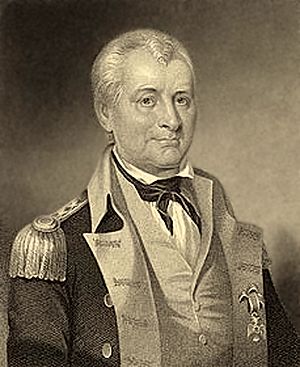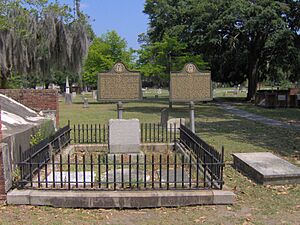Lachlan McIntosh facts for kids
Quick facts for kids
Lachlan McIntosh
|
|
|---|---|
 |
|
| Born | March 17, 1725 Raits, Badenoch, Scotland |
| Died | February 20, 1806 (aged 80) Savannah, Georgia, U.S. |
| Allegiance | |
| Service/ |
|
| Years of service | 1775-1783 |
| Rank | Brigadier General |
| Commands held | 1st Georgia Regiment Western Department of the Continental Army |
| Battles/wars | |
Lachlan McIntosh (born March 17, 1725 – died February 20, 1806) was an important military and political leader during the American Revolution. He was a Scottish American who played a big part in the early days of the United States. He is also known for a duel in 1777 where he shot and killed Button Gwinnett, who had signed the Declaration of Independence.
Contents
Growing Up in Georgia
Moving to a New Land
Lachlan McIntosh was born in Scotland, near a place called Raits. When he was 11 years old, in 1736, his father, John Mòr McIntosh, moved their family to Georgia. They were part of a group of 100 Scottish settlers.
These settlers started a new town called New Inverness (later renamed Darien). It was located by the Altamaha River. Lachlan's father led the group as they built this new settlement in the thick forest. Life on the frontier was dangerous. In 1737, Lachlan's younger brother Lewis was killed by an alligator while swimming.
Life in the Colony
At that time, Georgia was run by James Oglethorpe, who had founded the colony. Georgia was a very military-focused colony because there were often fights with Spanish Florida to the south. In 1740, during a conflict called the War of Jenkins' Ear, Lachlan's father was captured by the Spanish. He was held as a prisoner of war for two years.
Lachlan's father was eventually released, but his health was very poor. He died a few years later. Before he passed away, he had supported Oglethorpe and others who were against bringing slavery to Georgia. Many colonists wanted enslaved people to work their farms, but Oglethorpe and John McIntosh opposed it.
After his father died, Lachlan went to the Bethesda Orphanage in Savannah. He stayed there for two years. Later, he became a military cadet at Fort Frederica. Lachlan and his brother William almost went back to Scotland to join a rebellion there, but General Oglethorpe, who had become a friend, convinced them to stay in Georgia.
In 1748, McIntosh moved to Charleston, South Carolina. He worked as a clerk for Henry Laurens, a rich merchant. Laurens became a lifelong friend and mentor to Lachlan. In 1756, Lachlan married Sarah Threadcraft. They soon returned to Georgia, where Lachlan studied surveying. He bought land in the Altamaha River area and became a successful planter, growing rice with the help of slaves.
Fighting for Independence
Starting the War
By 1770, Lachlan McIntosh was a key leader in Georgia's movement for independence from Britain. In January 1775, he helped organize representatives for the Provincial Congress from his area. On January 7, 1776, McIntosh became a colonel in the Georgia Militia.
He formed the 1st Georgia Regiment and helped defend Savannah. He also helped push back a British attack during the Battle of the Rice Boats in the Savannah River. He was promoted to brigadier general in the Continental Army. His job was to protect Georgia's southern border from British attacks coming from Florida. In October 1776, McIntosh ordered his brother William to build Fort McIntosh on the Satilla River to help with this defense.
The Duel with Button Gwinnett
Between 1776 and 1777, McIntosh had a big disagreement with Button Gwinnett. Gwinnett was a powerful political leader in Georgia. Their rivalry started when McIntosh took over command of Georgia's Continental Battalion from Gwinnett in early 1776. The two men were leaders of opposing groups within the Patriot movement in Georgia.
Gwinnett later became a delegate to the Continental Congress and signed the United States Declaration of Independence. When he returned to Georgia, his allies helped him become president and commander-in-chief of the Committee of Safety. Gwinnett then started removing his political rivals from government and the military.
One of his first targets was George McIntosh, Lachlan's brother, who was accused of working against the revolution. Gwinnett also ordered Lachlan McIntosh to lead a poorly planned military mission into British Florida. The mission failed, and Gwinnett and McIntosh publicly blamed each other.
On May 1, 1777, Lachlan McIntosh spoke to the Georgia assembly. He strongly criticized Gwinnett, calling him a "scoundrel and lying rascal." Gwinnett then challenged McIntosh to a duel, demanding an apology or a fight. McIntosh refused to apologize.
On May 16, 1777, Gwinnett and McIntosh met for the duel with pistols. They fired almost at the same time. Gwinnett was shot in the thigh, and McIntosh was hit in the leg. McIntosh recovered from his wound, but Gwinnett's wound was very serious, and he died three days later.
Gwinnett's allies accused McIntosh of murder, but he was found not guilty in court. George Washington, the leader of the Continental Army, was worried that Gwinnett's friends might try to get revenge on McIntosh. So, he ordered McIntosh to join the Continental Army headquarters. McIntosh spent the winter of 1777–1778 with the army at Valley Forge, Pennsylvania.
Service on the Frontier and in the South
On May 26, 1778, McIntosh was put in charge of the Western Department of the Continental Army. His headquarters were at Fort Pitt (now Pittsburgh, Pennsylvania). He helped bring order to the frontier and planned an attack on the British stronghold of Fort Detroit. He built new forts, including Fort Laurens and Fort McIntosh, to prepare for the attack. However, the expedition against Fort Detroit did not succeed, and the troops had to turn back.
McIntosh was later replaced as commander of the Western Department. Washington then ordered him to return to the South to join General Benjamin Lincoln in Charleston, South Carolina. McIntosh marched to Augusta, Georgia, leading the Georgia troops. He then went to Savannah, where he commanded troops during the siege of Savannah.
After the battle, he moved his troops to Charleston to defend the city from the British Army. On May 12, 1780, General Lincoln had to surrender Charleston to British General Sir Henry Clinton. McIntosh was taken prisoner and remained captive until February 9, 1782. The war ended in 1783 with the Peace of Paris, which recognized American independence.
Later Life
After the war, McIntosh returned to his plantation. He found it had been ruined by the British. McIntosh tried to rebuild his property and businesses, but he spent the rest of his life in relative poverty.
In 1784, he was chosen to be part of the Continental Congress, but he never attended. In 1785, he was appointed to a group that worked with southern American Indian tribes. In 1787, he helped settle a border dispute between Georgia and South Carolina. McIntosh was also an original member of the Society of the Cincinnati, a group for officers who served in the Continental Army. In 1791, he was part of the group that officially welcomed President George Washington to Georgia.
Lachlan McIntosh died in Savannah, Georgia, on February 20, 1806. He is buried at Colonial Park Cemetery in Savannah. His great-great-nephews, James M. McIntosh and John Baillie McIntosh, became generals on opposite sides during the American Civil War.
Legacy and Honors
- The state of Georgia named McIntosh County in honor of his family. (The state also has a county named for Button Gwinnett, the man he killed in a duel.)


